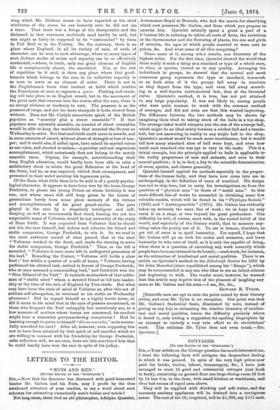LETTERS TO THE EDITOR.
"NUTS AND MEN.'
[TO TEl EDITOR OF TRY BPROTATOR.1
Sia,—Now that the Spectator has discussed with good-humoured banter Mr. Galton and his Note, may I profit by the thus awakened attention of your readers, to say a word about such schemes for estimating numerically men's bodies and minds?
Not long siege, there died an old philosopher, Adolphe Quetelet, Astronomer-Royal at Brussels, who had the mania for classifying which now possesses Mr. Galton, and from which you propose to
exorcise him. Quetelet actually spent a great a part of a lrborious life in reducing to tables all sorts of facts, the variations• of the thermometer and the flowering of plants, the size and girth- of recruits, the ages at which people married or were sent to prison, &c. And what came of all this computing ?
There came of it, among other results, one discovery of the
highest order. For the first time, Quetelet showed the world that there really is such a thing as a standard or type of a whole race, or class, or species, viewed as to any quality. Arranging his individuals in groups, he showed that the central and most numerous group represents the type or standard, inasmuch as on both sides of it the groups fall away in numbers as they depart from the type, and even fall away accord- ing to a well-known mathematical law, that of the binomial' curve. Quetelet's method, it is true, has not yet attained• to any large popularity. It was not likely to, among people who were quite content to work with the common method, of averages, and did not even see that this wanted improving. The difference between the two methods may be shown by. imagining them tried in taking stock of the balls in a toy-shop. The average-taker would compute you the size of the average ball, which might be an ideal entity between a cricket-ball and a tennis- ball, but not answering in reality to any single ball in the shop. Quetelet's method would be much more troublesome, but it would' tell how many standard sizes of ball were kept, and even how- much each standard size was apt to vary in the make. This is a trivial example, but the principle applied to balls is applicable to the bodily proportions of men and animals, and even to their- mental qualities ; it is, in fact, a key to the scientific determination of races, species, and classes generally.
Quetelet himself applied his methods especially to the propor- tions of the human body, and they have now come into use in- anthropology, in the definition of races of mankind. His design was not to stop here, but to carry his investigations on from the- qualities of " physical man " to those of " moral man." In this more difficult line of works he succeeded in obtaining some few valuable results, which will be found in his " Physique Sociale" (1869) and " Anthropometrie " (1870). Mr. Galion has evidently taken up seriously the same line of work ; let us hope he may carry it on a stage or two beyond his great predecessor. One difficulty he will, of course, meet with, in the rooted belief of the world, and especially of the literary world, that to measure any- thing takes the poetry out of it. To err is human, therefore, to- get rid of error is to spoil humanity. For myself, I hope that Mr. Galton will go on with his scales and measures, and leave humanity to take care of itself, as it is only too capable of doing,. when there is a question of executing any work correctly which- people have been accustomed to do loosely, —such work, for instance,. as the estimation of intellectual add moral qualities. There is an article on Quetelet's method in the Edinburgh Review for 1850 by- Sir John Herschel (since republished among his " Essays"), which may be recommended to any one who likes to see an infant science just beginning to walk. The reader must, however, be warned that this article may deprive him of the pleasure of laughing any more at Mr. Galton and his nuts.—I am, Sir, &c., EDWARD B. TYLOR.
[Scientific men are apt to miss the point raised by their literary
critics, and even Mr. Tylor is no exception. Our point was that Mr. Galton's Statistical Scale, illustrated by nuts, instead of giving us any help in estimating the relative intensity of intellec- tual and moral qualities, leaves the difficulty precisely where- it found it, only adding a suggestion for spoiling biographies by an attempt to embody a very vain effort to do statisticians" work. This criticism Mr. Tylor does not even touch.—ED.- Spectator.]


































 Previous page
Previous page